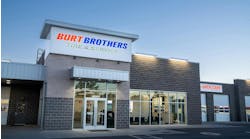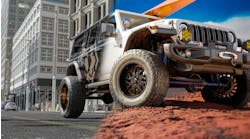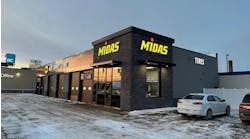It’s estimated that 70% of private businesses in the U.S. never have a successful exit. While overall M&A activity among tire retailers, wholesalers and commercial tire dealerships remains active but noticeably slower, it’s harder for wholesalers and commercial tire dealerships to have a sale event as compared with retailers.
The reasons for this have to do with the nature of these businesses. Overall, tire wholesalers and commercial tire dealerships have lower margins than tire retailers. Earnings before taxes, depreciation and amortization (EBITDA) margins can be half of those of tire retailers.
Lower margins, in many cases, make these businesses unattractive to all but a small handful of financial investors like private equity groups, who look to invest, build a company up and then often sell to a larger private equity group. If there is no larger private equity group that wants to take it from there, the odds of an exit decline, as they are left only with a pool of strategic buyers.
The strategic buyer pool may be limited to larger groups that sell the same brands and types of tires as the wholesaler or commercial dealership. If you’re strong with Bridgestone, for example, you may only be attractive to another Bridgestone group. If you are in the same geography as a larger version of you, a buyer may not even need nor want to purchase your business. Only someone from another geography might, but then, the tire manufacturer might have some sway into that outcome, as well.
I encourage tire wholesalers and commercial tire dealerships that find themselves in those situations to not despair, but rather investigate how employee stock ownership plans (ESOPs) work and how they are viable alternatives in an exit. To learn more about the indicators of what makes a good ESOP, as well as the benefits and the pitfalls, I turned to Focus’ Corporate Finance Head, Bob Beard, who executes ESOPs on behalf of our clients.
“One of the ideal indicators that your company is a good candidate for an ESOP is to have a relatively young and stable workforce,” says Beard. “You want the average age of the worker to be probably no more than mid-50s. The reason is you need to accumulate cash over time to be able to pay folks when they leave, because that's how an ESOP works.
“And if you have an older workforce, you may not have enough time to accumulate cash if everybody's going to hit 65, which is generally the age of retirement for a traditional ERISA plan.
“As to the stability of the workforce, you don't want a lot of turn-over because you're going to wind up with a lot of people with partial benefits and it gets very convoluted and expensive as you may be forced to reserve the cash now to meet the related ESOP obligation later.”
“If over half my workforce has been with me over five years, then I'm probably a really good candidate,” says Beard. “And if the average age of my workforce is 55 or less, I'm probably a good candidate.”
He adds that rural tire dealerships with their relatively more stable workforce might be ideal candidates for ESOPs.
There is no minimum revenue size or level of profitability Beard has in mind for an ESOP. “I did one ESOP where (the business) was $3 million in revenue and a classically challenging situation in that it was a very project-oriented, engineering business (that’s) very difficult to sell otherwise. You probably couldn't do an ESOP with a small proprietorship because you may not be able to raise the debt involved and there are ongoing expenses to managing an ESOP a business must be able to afford.
“Stability matters more than the EBITDA margins themselves.” continues Beard. “I know in any kind of retail and wholesale environment, you're going to have cyclicality to some degree, but you want to be able to stomach the bad times. And if the bad times come every five to seven years, which is a typical economic cycle, you can work through that. If it's more cyclical than that, it's difficult.
“I always say in an ESOP you should be able to get about 2x conservatively and generally expect 3x your EBITDA level in third-party bank debt,” says Beard, who adds that when a business has less debt on the books, more new debt can go directly to the owner in an ESOP.
What are the top benefits of an ESOP for a tire dealer? “First, the valuation you get can be very fair,” says Beard. “And by the way, this valuation is always negotiated. The way it works is you have third party fiduciaries who are on the other side of the table. They're the trustees and they have in their back pocket an appraisal that we aren’t privy to as advisors to a potential ESOP. But we are negotiating a price just like any other transaction. Those appraisals are generally reasonable. I haven't seen a whole lot of ESOPs where the parties thought it was way out of line.
“For other benefits, let's look at the company level first and then we'll talk a little bit about the owner who's selling,” he says. “At the company level, an ESOP is an attractive employee benefit that can be used in recruiting and retention. It is the same as a company-sponsored, defined benefit plan, but one in which the individual employee does not have to contribute money into the plan.
An ESOP supplements any other retirement plan or 401(k)that that company may have. If it's a 100% ESOP, the company doesn't pay any federal income taxes. This tax-exempt status comes into play when structuring and analyzing the debt load the business can carry. In a relatively well-run business, because the debt is generally conservatively structured and the company is shielded from taxes, you pay the debt off early.
The second benefit is that an ESOP does provide that sense of ownership employees have in the business. “Some people say, ‘Oh, if I've got 50 or 60 people, they're not going to care about ownership.’ Well, yes, they do. And when that benefit starts to show up when they retire, if the company's a real well-run business over time, the retirement benefit from the ESOP could well outstrip their 401(k).”
It also can provide some reassurance that the business is less likely to be sold anytime soon. So in that way, it’s also an employee retention tool, according to Beard.
From the owner/seller’s standpoint, they basically get some immediate liquidity, depending on how much leverage is put on the business, with the rest of the valuation coming in the form of a seller note paid off over time — and potentially with equity kickers.
“Now there is some tax complexity to this,” says Beard, “and tax advisors need to be engaged prior to the adoption. But with proper structure, the owner of the business, when they receive the cash at closing, may actually reinvest that money in certain qualified securities and they don't have to pay federal taxes on the reinvested amounts. It's deferred. There are even ways for the seller to pull some of that cash out at closing and still defer the tax consequences.”
Now what about the top pitfalls to look out for? “The debt in an ESOP is very, very difficult to restructure,” says Beard. “In a non-ESOP company, if I'm a bank or a financial institution that has lent you money and something goes awry, generally we can sit down and figure out a way to deal with it. With an ESOP, you have a trustee and that trustee has a fiduciary responsibility to the employees. It’s harder to cut a deal very easily So there's somewhat less flexibility in what I will call this sort of board of director-level decision.
“You've got somebody looking over your shoulder who doesn't know a lot about your business. Now these trustees are very experienced and knowledgeable people. I really have a lot of respect for them. But say, for example, you want to close a facility in a multi-location business and lay off employees. Guess what? You’re going to have to set aside money in the ESOP for the people that you just laid off. Now you don't necessarily have to pay them that day, depending on their age, but you better be putting it away. And the trustee will get in the middle of that decision.”
Another potential pitfall is ongoing annual expenses to maintain that ESOP. For a middle market company, that is somewhere between $50,000 and $100,000 annually. Additionally, if it was decided by senior management that the business should be sold, continues Beard, “in an ESOP, there is corporate governance involved there.
“Technically, the trust owns the shares, but the employees get a vote. And you cannot sell that business for less than the prior-year valuation. Now that sounds OK on the surface, but as investment bankers, we really don't like to see all those hoops that we have to jump through, where the valuation is set, as opposed to being driven by the market.”




